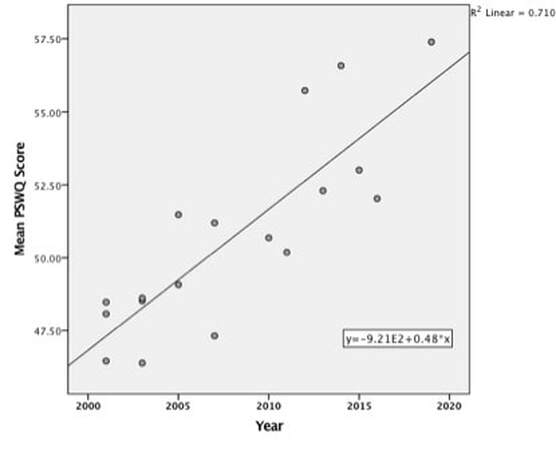I’ve been a “worry” researcher for much of the past 25 years, so have had a keen interest in what turns “normal” worrying in to the pathological worrying that people find so distressing. And I’ve been particularly interested in whether anxiety symptoms such as worrying are on the increase or not – interested enough to write a whole book on the topic (1).
What was perplexing during the writing of “The Anxiety Epidemic” was that almost everyone – in almost all spheres of life – were claiming that anxiety symptoms were on the increase in a modern world that not only exacerbated traditional anxieties but also created new forms of stress that generated brand-new sources of anxiety (2,3) - yet, it was difficult to find any reliable evidence over time that anxiety symptoms were increasing in frequency. Was this ‘Anxiety Epidemic’ a result of more people being mental health aware and seeking treatment when they may not have done in previous times, or was it a genuine increase in the severity and frequency of anxiety symptoms?
Just a few months ago, an informal survey by the BBC suggested that the number of students seeking mental health support while studying at university had increased by more than 50% in five years (4). So, was this an example of greater mental health awareness leading students to seek help, or was it a genuine increase in the frequency and severity of mental health problems in this population?
Much of the research on worrying we’ve carried out at the University of Sussex has been conducted on undergraduate students, so we have 20-25 years worth of data on worrying from this group. Just last week, we’d finished an on-line questionnaire designed to validate a new worry scale specifically for university students. Interestingly, in this study we also included a traditional and reliable measure of pathological worrying called the Penn State Worry Questionnaire (PSWQ). This scale has been around for 30 years and is considered the gold standard measure of pathological worrying.
What caught my attention was the mean PSWQ score for this study (N=217). The mean score was 57.39 (SD 9.87). This seemed rather high – and most of the data in the survey was collected outside of exam and assessment periods that might have inflated the scores.
Looking at the available norms for the PSWQ, the average score given for college student samples was 47.42 (5)– 10 points lower than the mean for our current group. But this norm was based on college student data from almost 20 years ago. Was this an indication that worry had indeed increased in frequency and severity in this population over the past two decades?
I decided to look back at the PSWQ data we’d collected from student populations at the University of Sussex over the past twenty years. I found 18 studies spanning the years 2001 to our present survey conducted in 2019 providing data from a total of 1369 respondents. Some of these data were collected during lab-based experiments others during questionnaires and surveys, but even in the case of lab-based studies, the PSWQ was completed at the outset of the study and scores would not have been influenced by any experimental manipulations. I must admit, I wasn’t expecting such a clear pattern of results.
So what do we make of this? First, this seems to demonstrate a real increase in reported anxiety-related symptoms over time. This is consistent with student populations not just becoming more mental health aware and being increasingly likely to seek help, it signals a genuine increase in the frequency and severity of these symptoms as indicated by reliable measures of student worry. Second, the mean score for the PSWQ in 2019 is alarmingly close to the PSWQ scores normally considered to be a reliable indicator of Generalized Anxiety Disorder (a minimum PSWQ score of between 62-68(5)). Indeed, in our most recent survey, 26.4% of student respondents scored 62 or higher on the PSWQ and 11.6% scored higher than 68. That’s equivalent to 1 in 4 of all students on a campus suffering diagnosable GAD or sub-clinical GAD symptoms – enough to overwhelm any university counselling and medical services.
What’s causing this unrelenting increase in anxiety-related worrying in students? At this point, who knows? There are lots of suspects – and I cover these in more detail in my book “The Anxiety Epidemic”. Some of these suspects include increasing student debt since the introduction of university fees in the UK in 1998, increasing student numbers resulting in less support from academic staff, increased systematic educational testing introducing youngsters to the possibility of failure from an early age, and the rise of social media since the mid-1990s which has been identified as a cause of social anxieties and disconnectedness as we view daily what seem like the rich lives and social successes of others(6). But whatever the cause, there is certainly an anxiety epidemic on the university campus.
(1) Davey GCL (2018) The Anxiety Epidemic. Little Brown Books.
(2) https://www.nytimes.com/2017/06/10/style/anxiety-is-the-new-depression-xanax.html
(3) http://www.telegraph.co.uk/health-fitness/mind/how-anxiety-became-a-modern-epidemic-greater-than-depression/
(4) https://www.bbc.co.uk/news/uk-england-45824598
(5) Startup HM & Erickson TM (2003) The Penn State Worry Questionnaire (PSWQ). In GCL Davey & A Wells (Eds) Worry & Its Psychological Disorders. Wiley.
(6) Davey GCL (2018) The Anxiety Epidemic. Chapter 3. Little Brown Books.

 RSS Feed
RSS Feed